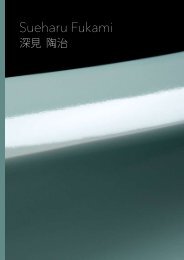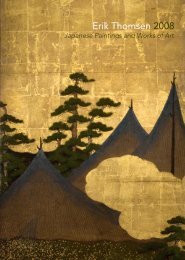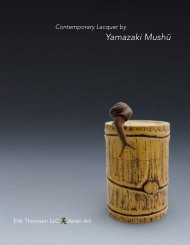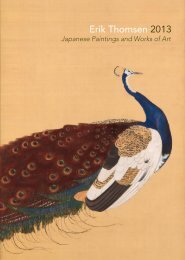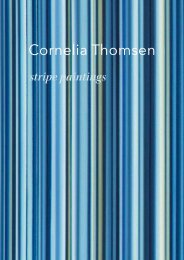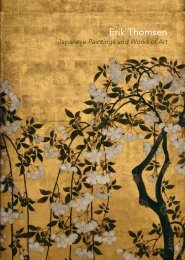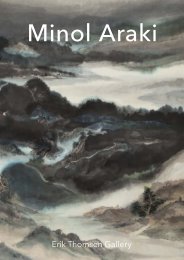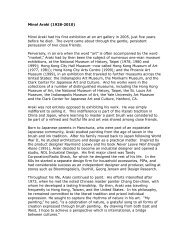View publication (pdf file 6.5 mb) - Erik Thomsen
View publication (pdf file 6.5 mb) - Erik Thomsen
View publication (pdf file 6.5 mb) - Erik Thomsen
- No tags were found...
Create successful ePaper yourself
Turn your PDF publications into a flip-book with our unique Google optimized e-Paper software.
9Sōju 双 樹 (ac. Taishō Period)Sea Gulls by the SeashoreTaishō Period (1912 – 26), 1920sH 69 ¼" × W 68 ¾"(175.8 cm × 174.8 cm)Two-panel folding screenInk, colors, gofun and silver on paper.Signature: Sōju 双 樹Seal:Sō 双In this striking composition, we see two seagullson the seashore, seemingly overwhelmed by theincoming waves. The painting is a fascinating studyof movement and patterns that spread across itssurface.screen dates from the innovative period of theearly 1920s. The Taishō period was noted for agreat flowering of the arts, with a proliferation ofart schools and the education of great many skilledstudents. Unfortunately for them (and for us) theperiod was also known for its great disasters: theKantō Earthquake of 1923, the global economiccrash of 1929 and the resulting depression thatchanged the future for a nu<strong>mb</strong>er of promisingartists in a decidedly negative way, sometimes withcatastrophic effect. 1 Much research remains to bedone about artists of this period, including the identityand biography of the artist who created thismasterpiece.Not only is the screen remarkable for its daringcomposition, but also for its display of technicalability. For one thing, this painting is a masterpiecein the use of gofun, or seashell powder. Althoughgofun has been used by Japanese artists for centuries,its use rarely reaches the level of technicalperfection seen in this screen. We can see extensiveuse of gofun on the waves and on the bodies ofthe gulls, which thereby achieve a tactile threedimensionalfeel. Detailed use of the material canbe seen on the seagull at the back, for example,where a wave of white gofun faintly washes overits left foot.Another technical element is the sophisticated useof sprinkled silver flakes, which can be seen notonly on the beach, simulating the wet sand sparklingin the sunlight, but also under the layers of gofunwaves,where it mimics reflecting sand under water.The artist has also darkened the rim of sand directlybordering the incoming waves, cleverly giving animpression of water-logged sand.As for the artist, research still remains to be done.Little is known, beyond the evidence of the screenitself. Judging from the style, we know that it musthave been a Nihonga artist with great talent. Andjudging from similar objects, we can say that the44 45



